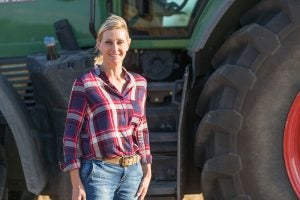Farmers Edge’s CEO explores what’s on the cusp of agriculture and gives his predictions for what 2021 may look like for this industry
As more and more biotech and precision agriculture tools become available, not to mention a shifting political landscape and labor market, it’s no surprise that change always seems right around the corner for the agriculture industry. Much of those changes, especially as they apply to production efficiencies and improved environmental impacts, are resoundingly good. However, the cadence of these changes can sometimes be hard to manage. If we take a step back, we can look at the broader trends and, perhaps, get a perspective on which direction our sector is headed as a whole.
With that in mind, I can, in good faith, predict some of the shifts that we will see for the coming year. Here are my six biggest predictions for the agricultural industry in 2021:
1. 2021 will be a breakout year for women in agriculture
The connected farm and modern technologies will empower more women to run farms and to take leadership positions in the industry. Today, brains — not brawn — are the new key to a farm’s success as technology closes the gender gap. In addition, because farm families are getting smaller, all farm kids are getting the same exposure and field experience. Technology makes that old notion of only boys in the field a thing of the past.
It’s truly exciting to see this shift taking place, and I believe 2021 will be a breakout year for women in the industry. Just looking at our staff at Farmers Edge, we are seeing many more women occupying technical roles such as precision technology specialists who install hardware for our growers and software engineers working for our innovation hub, which has increased more than where we were even just five years ago.

2. Nitrous oxide mandates are on the horizon
In 2021, we may see new regulations on nitrous oxide. While less abundant than CO2, nitrous oxide is 300x more harmful to the environment, and it’s increasing in the atmosphere. Agriculture is among the largest contributors of nitrous oxide because it is produced as a by-product of nitrogen-based fertilizer. In 2021, we’ll increase the adoption of data-driven fertilizer applications that will apply precisely the right amount needed to reduce nitrous oxide emissions. Mandates or not, using technology to prove you’ve reduced your nitrogen applications will become even more important.
3. With carbon credits — money talks
In 2021, you can bet we’ll start to see carbon credits in the $30 to $50 per acre range. That kind of money will certainly get the attention of growers.
Agriculture has been dabbling with carbon credits for a decade through small pilot programs. Now we’re seeing broader interest and activity across North America, from both government agencies and large corporations. As the protocols get defined and the markets develop, growers will start to identify the opportunities that fit best for them. Those looking to generate carbon credits will turn to their digital tools and farm management platform to capture the required data from their fields and operations to easily monitor and fulfill the reporting requirements.
Consumer demand will also make carbon offsets attractive. More consumers are worried about where their food comes from, so if a grocery chain can legitimately market their bread as being from farms that have reduced their carbon emissions, that bread will go for a premium. Consumers will pay more knowing the farmer is doing everything to safeguard the environment.
4. 2021 will see an abundance of plant-based food served with a side of data
Plant-based eating is on the rise globally, and the market is expected to surpass $35 billion (USD) by 2024. Fueling this trend is burgeoning consumer demand for transparency and knowing precisely where their food has come from and how it was cultivated, directly back to the farm of origin.
Growers will rely on digital tools that tell in detail how protein-rich crops like canola, lentils, and peas were grown, harvested and transported to the consumer, through automated audit reports. This information will also enable growers to earn premiums on crops that meet stringent quality standards, including organic and non-GMO.
Beyond crop traceability, growers will continue to use digital tools to determine which variety of crops they will grow, where to plant them for the best yield, and how to manage supply and demand to help prevent shortages of specific crops. Not too long ago, peas fell out of favor among growers, but we are now seeing a resurgence of peas to support the production of foods with plant-based protein.

5. Digital farming will support efforts to help stop the spread of COVID-19 on the farm and among agricultural professionals
The COVID-19 pandemic showed the fragility of our global supply chains and awakened consumers to the importance of agriculture. While people dealt with massive shortages of toilet paper and office furniture, there was never a shortage of food as a whole. People everywhere have a renewed appreciation for farmers now, which is tremendous.
In 2021, growers will digitize their farms at a faster rate and use farm platforms to engage electronically with partners, insurance agents and bankers to conduct routine business, instead of meeting face to face as part of their pandemic mitigation strategy. Growers and agricultural professionals will also increase investment in personal protective equipment for their staff and establish better social distancing in the field to mitigate the risk of the virus spreading.
6. The USDA will be under pressure to change its stance on digital InsurTech tools
Today, the USDA still requires agents and brokers to meet face to face with growers even though a digital platform saves time and money.
With the pandemic, the USDA will finally see the advantage of a safe, remote option as more growers who use digital farming practices that maximize yield and mitigate risks will be rewarded by insurance companies with lower premiums that match precisely the right level of risk.
While the USDA has been slow to embrace the digital transformation in how crop insurance is underwritten, how claims are filed and processed, and how acreage reports are created and delivered, they will make big moves forward in 2021 to embrace agri-insurance technology.
Wade Barnes is CEO and co-founder of Farmers Edge, a leading digital agriculture company. In his spare time, you can find Barnes at his farm in Birtle, Manitoba, where he farms wheat, canola, barley, and peas.


